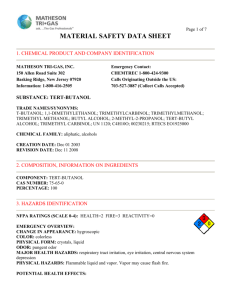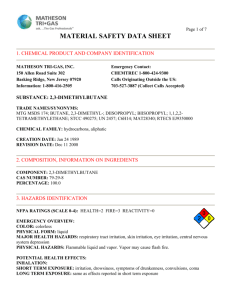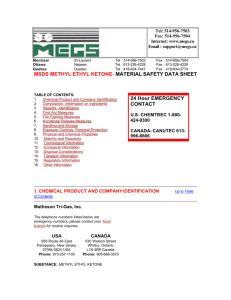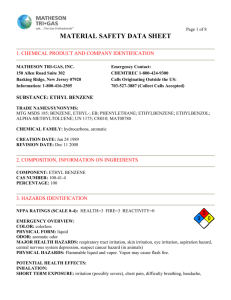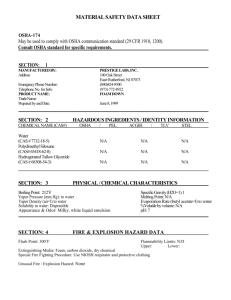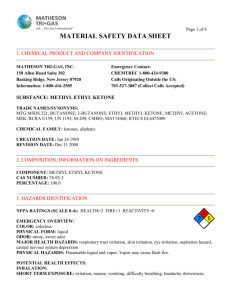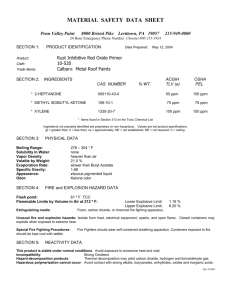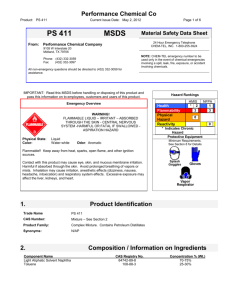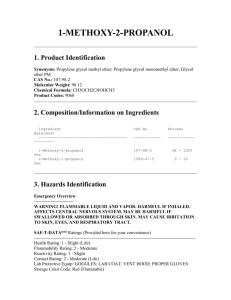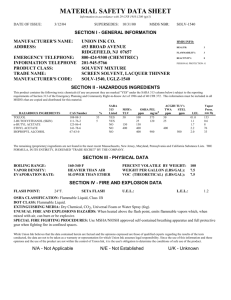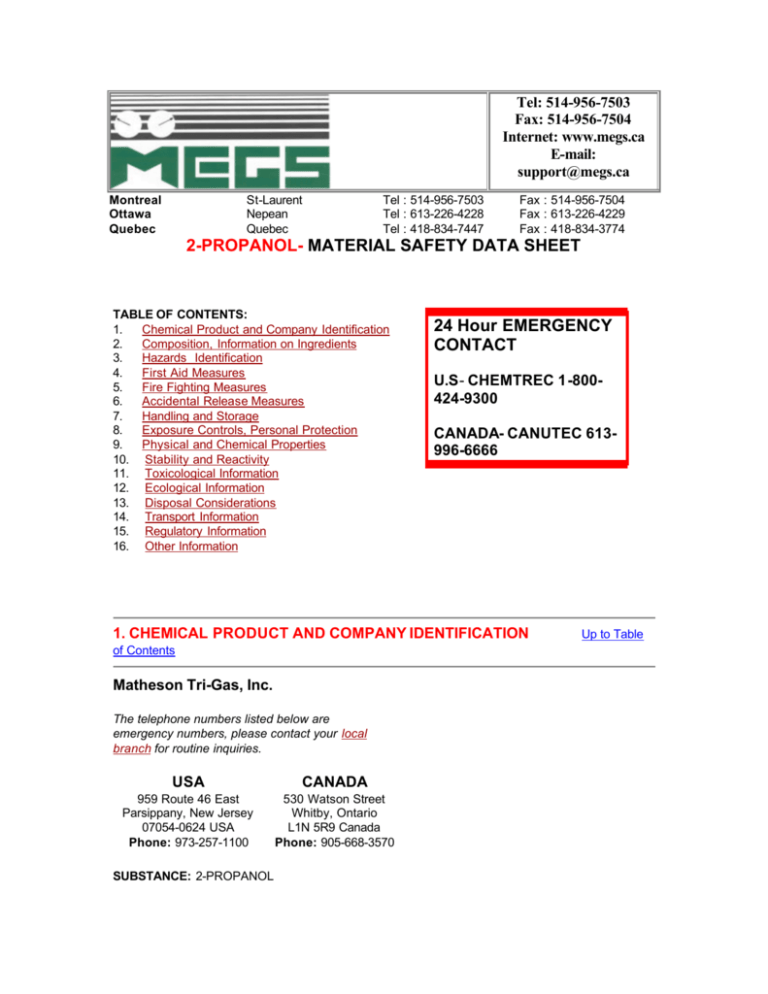
Tel: 514-956-7503
Fax: 514-956-7504
Internet: www.megs.ca
E-mail:
support@megs.ca
Montreal
Ottawa
Quebec
St-Laurent
Nepean
Quebec
Tel : 514-956-7503
Tel : 613-226-4228
Tel : 418-834-7447
Fax : 514-956-7504
Fax : 613-226-4229
Fax : 418-834-3774
2-PROPANOL- MATERIAL SAFETY DATA SHEET
TABLE OF CONTENTS:
1.
Chemical Product and Company Identification
2.
Composition, Information on Ingredients
3.
Hazards Identification
4.
First Aid Measures
5.
Fire Fighting Measures
6.
Accidental Release Measures
7.
Handling and Storage
8.
Exposure Controls, Personal Protection
9.
Physical and Chemical Properties
10. Stability and Reactivity
11. Toxicological Information
12. Ecological Information
13. Disposal Considerations
14. Transport Information
15. Regulatory Information
16. Other Information
24 Hour EMERGENCY
CONTACT
U.S- CHEMTREC 1-800424-9300
CANADA- CANUTEC 613996-6666
1. CHEMICAL PRODUCT AND COMPANY IDENTIFICATION-----------Up to Table
of Contents
Matheson Tri-Gas, Inc.
The telephone numbers listed below are
emergency numbers, please contact your local
branch for routine inquiries.
USA
CANADA
959 Route 46 East
Parsippany, New Jersey
07054-0624 USA
Phone: 973-257-1100
530 Watson Street
Whitby, Ontario
L1N 5R9 Canada
Phone: 905-668-3570
SUBSTANCE: 2-PROPANOL
SYMBOL: C3H8O
TRADE NAMES/SYNONYMS:
ISOPROPANOL; ETHYL CARBINOL; DIMETHYLCARBINOL; 2-PROPANOL; ISOHOL; SECPROPYL ALCOHOL; PROPYL ALCOHOL; STCC 4909205; UN 1219; C3H8O; MAT12090;
RTECS NT8050000
CHEMICAL FAMILY: alcohols, aliphatic
CREATION DATE: Jan 24 1989
REVISION DATE: Mar 16 1999
2. COMPOSITION, INFORMATION ON INGREDIENTS-----------Up to Table of
Contents
COMPONENT: ISOPROPYL ALCOHOL
CAS NUMBER: 67-63-0
EC NUMBER (EINECS): 200-661-7
EC INDEX NUMBER: 603-003-00-0
PERCENTAGE: 100.0
3. HAZARDS IDENTIFICATION-----------Up to Table of Contents
NFPA RATINGS (SCALE 0-4): HEALTH=2 FIRE=3 REACTIVITY=0
WHMIS CLASSIFICATION: B
EC CLASSIFICATION (ASSIGNED):
F Highly Flammable
R 11
EC Classification may be inconsistent with independently-researched data.
EMERGENCY OVERVIEW:
Color: colorless
Physical Form: liquid
Odor: alcohol odor
Major Health Hazards: respiratory tract irritation, eye irritation, central nervous system
depression
Physical Hazards: Flammable liquid and vapor. Vapor may cause flash fire.
POTENTIAL HEALTH EFFECTS:
INHALATION:
Short Term Exposure: same as effects reported in other routes of exposure, irritation,
symptoms of drunkenness
Long Term Exposure: no information on significant adverse effects
SKIN CONTACT:
Short Term Exposure: same as effects reported in short term ingestion, mild irritation,
symptoms of drunkenness
Long Term Exposure: no information on significant adverse effects
EYE CONTACT:
Short Term Exposure: irritation, eye damage
Long Term Exposure: same as effects reported in short term exposure
INGESTION:
Short Term Exposure: nausea, stomach pain, irregular heartbeat, headache, symptoms of
drunkenness, lung congestion, kidney damage, coma
Long Term Exposure: no information on significant adverse effects
CARCINOGEN STATUS:
OSHA: N
NTP: N
IARC: N
4. FIRST AID MEASURES-----------Up to Table of Contents
INHALATION:
Remove from exposure immediately. Use a bag valve mask or similar device to perform artificial
respiration (rescue breathing) if needed. Get medical attention.
SKIN CONTACT:
Remove contaminated clothing, jewelry, and shoes immediately. Wash with soap or mild
detergent and large amounts of water until no evidence of chemical remains (at least 15-20
minutes). Get medical attention, if needed.
EYE CONTACT:
Wash eyes immediately with large amounts of water or normal saline, occasionally lifting upper
and lower lids, until no evidence of chemical remains. Get medical attention immediately.
INGESTION:
Contact local poison control center or physician immediately. Never make an unconscious person
vomit or drink fluids. When vomiting occurs, keep head lower than hips to help prevent aspiration.
If person is unconscious, turn head to side. Get medical attention immediately.
NOTE TO PHYSICIAN:
For ingestion, consider gastric lavage and activated charcoal slurry. Consider oxygen.
5. FIRE FIGHTING MEASURES-----------Up to Table of Contents
FIRE AND EXPLOSION HAZARDS:
Severe fire hazard. The vapor is heavier than air. Vapors or gases may ignite at distant ignition
sources and flash back. Vapor/air mixtures are explosive.
EXTINGUISHING MEDIA:
alcohol resistant foam, carbon dioxide, regular dry chemical, water, alcohol resistant foam
Large fires: Use alcohol-resistant foam or flood with fine water spray.
FIRE FIGHTING:
Move container from fire area if it can be done without risk. Cool containers with water spray until
well after the fire is out. Stay away from the ends of tanks. For fires in cargo or storage area: Cool
containers with water from unmanned hose holder or monitor nozzles until well after fire is out. If
this is impossible then take the following precautions: Keep unnecessary people away, isolate
hazard area and deny entry. Let the fire burn. Withdraw immediately in case of rising sound from
venting safety device or any discoloration of tanks due to fire. For tank, rail car or tank truck:
Evacuation radius: 800 meters (1/2 mile). Do not attempt to extinguish fire unless flow of material
can be stopped first. Flood with fine water spray. Do not scatter spilled material with highpressure water streams. Cool containers with water spray until well after the fire is out. Apply
water from a protected location or from a safe distance. Avoid inhalation of material or
combustion by-products. Stay upwind and keep out of low areas. Water may be ineffective.
FLASH POINT:
54 F (12 C) (CC)
LOWER FLAMMABLE LIMIT:
2.0%
UPPER FLAMMABLE LIMIT:
12.7% @ 93.3 C
AUTOIGNITION:
750 F (399 C)
FLAMMABILITY CLASS (OSHA):
IB
6. ACCIDENTAL RELEASE MEASURES-----------Up to Table of Contents
OCCUPATIONAL RELEASE:
Avoid heat, flames, sparks and other sources of ignition. Remove sources of ignition. Stop leak if
possible without personal risk. Reduce vapors with water spray. Small spills: Absorb with sand or
other non-combustible material. Collect spilled material in appropriate container for disposal.
Large spills: Dike for later disposal. Keep unnecessary people away, isolate hazard area and
deny entry. Stay upwind and keep out of low areas.
7. HANDLING AND STORAGE-----------Up to Table of Contents
Store and handle in accordance with all current regulations and standards. Subject to storage
regulations: U.S. OSHA 29 CFR 1910.106. Grounding and bonding required. Keep separated
from incompatible substances.
8. EXPOSURE CONTROLS, PERSONAL PROTECTION-----------Up to Table of
Contents
EXPOSURE LIMITS:
ISOPROPYL ALCOHOL:
ISOPROPYL ALCOHOL (ISOPROPANOL; 2-PROPANOL):
400 ppm (983 mg/m3) OSHA TWA
500 ppm (1230 mg/m3) OSHA STEL (vacated by 58 FR 35338, June 30, 1993)
400 ppm (983 mg/m3) ACGIH TWA
500 ppm (1230 mg/m3) ACGIH STEL
400 ppm (983 mg/m3) NIOSH recommended TWA 10 hour(s)
500 ppm (1230 mg/m3) NIOSH recommended STEL
VENTILATION: Provide local exhaust ventilation system. Ventilation equipment should be
explosion-resistant if explosive concentrations of material are present. Ensure compliance with
applicable exposure limits.
EYE PROTECTION: Wear splash resistant safety goggles. Provide an emergency eye wash
fountain and quick drench shower in the immediate work area.
CLOTHING: Wear appropriate chemical resistant clothing.
GLOVES: Wear appropriate chemical resistant gloves.
RESPIRATOR: The following respirators and maximum use concentrations are drawn from
NIOSH and/or OSHA.
2000 ppm
Any supplied-air respirator.
Any chemical cartridge respirator with a full facepiece and organic vapor cartridge(s).
Any air-purifying respirator with a full facepiece and an organic vapor canister.
Any powered, air-purifying respirator with organic vapor cartridge(s).
Any self-contained breathing apparatus with a full facepiece.
Any supplied-air respirator with a full facepiece.
Escape Any air-purifying respirator with a full facepiece and an organic vapor canister.
Any appropriate escape-type, self-contained breathing apparatus.
For Unknown Concentrations or Immediately Dangerous to Life or Health Any supplied-air respirator with full facepiece and operated in a pressure-demand or other
positive-pressure mode in combination with a separate escape supply.
Any self-contained breathing apparatus with a full facepiece.
9. PHYSICAL AND CHEMICAL PROPERTIES-----------Up to Table of Contents
PHYSICAL STATE: liquid
COLOR: colorless
ODOR: alcohol odor
MOLECULAR WEIGHT: 60.10
MOLECULAR FORMULA: C-H3-C-H-(O-H)-C-H3
BOILING POINT: 180 F (82 C)
FREEZING POINT: -128 F (-89 C)
VAPOR PRESSURE: 40 mmHg @ 24 C
VAPOR DENSITY (air=1): 2.1
SPECIFIC GRAVITY (water=1): 0.7855
WATER SOLUBILITY: soluble
PH: Not available
VOLATILITY: 100%
ODOR THRESHOLD: 40-45 ppm
EVAPORATION RATE: 2.88 (butyl acetate=1)
COEFFICIENT OF WATER/OIL DISTRIBUTION: Not available
SOLVENT SOLUBILITY:
Soluble: alcohol, ether, chloroform, acetone, benzene
Insoluble: salt solutions
10. STABILITY AND REACTIVITY-----------Up to Table of Contents
REACTIVITY:
Stable at normal temperatures and pressure.
CONDITIONS TO AVOID:
Avoid heat, flames, sparks and other sources of ignition. Containers may rupture or explode if
exposed to heat.
INCOMPATIBILITIES:
acids, metals, oxidizing materials, combustible materials, halogens, peroxides, bases, metal salts
HAZARDOUS DECOMPOSITION:
Thermal decomposition products: oxides of carbon
POLYMERIZATION:
Will not polymerize.
11. TOXICOLOGICAL INFORMATION-----------Up to Table of Contents
ISOPROPYL ALCOHOL:
Irritation Data:
500 mg skin-rabbit mild; 100 mg eyes-rabbit severe; 10 mg eyes-rabbit moderate; 100 mg/24
hour(s) eyes-rabbit moderate
Toxicity Data:
16000 ppm/8 hour(s) inhalation-rat LC50; 12800 mg/kg skin-rabbit LD50; 5045 mg/kg oral-rat
LD50
Carcinogen Status:
IARC: Human Inadequate Evidence, Animal Inadequate Evidence, Group 3; EC: Category 1
Local Effects:
Irritant: inhalation, eye
Acute Toxicity Level:
Slightly Toxic: inhalation, dermal absorption, ingestion
Target Organs:
central nervous system
Medical Conditions Aggravated By Exposure:
kidney disorders, liver disorders, respiratory disorders, skin disorders and allergies
Mutagenic Data:
Available.
Reproductive Effects Data:
Available.
12. ECOLOGICAL INFORMATION-----------Up to Table of Contents
ECOTOXICITY DATA:
Fish Toxicity:
730 ug/L 96 hour(s) LC50 (Mortality) Brook trout (Salvelinus fontinalis)
Invertebrate Toxicity:
3142000 ug/L 48 hour(s) EC20 (Biomass) Ciliate Protozoa (Tetrahymena thermophila)
Algal Toxicity:
2200 ug/L 96 hour(s) EC50 (Growth) Green algae (Chlorella pyrenoidosa)
Fate and Transport:
Bioconcentration:
0.38 ug/L 15 hour(s) BCF (Residue) Red swamp crayfish (Procambarus clarki) 10 ug/L
Environmental Summary:
Highly toxic to aquatic life.
13. DISPOSAL CONSIDERATIONS-----------Up to Table of Contents
Subject to disposal regulations: U.S. EPA 40 CFR 262. Hazardous Waste Number(s): D001.
Dispose in accordance with all applicable regulations.
14. TRANSPORT INFORMATION-----------Up to Table of Contents
U.S. DOT 49 CFR 172.101. SHIPPING NAME-UN NUMBER; HAZARD CLASS;
PACKING GROUP; LABEL:
Isopropanol-UN1219; 3; II; Flammable liquid
15. REGULATORY INFORMATION-----------Up to Table of Contents
U.S. REGULATIONS:
TSCA INVENTORY STATUS: Y
TSCA 12(b) EXPORT NOTIFICATION: Y
ISOPROPANOL
CAS NUMBER: 67-63-0
SECTION 4
CERCLA SECTION 103 (40CFR302.4): N
SARA SECTION 302 (40CFR355.30): N
SARA SECTION 304 (40CFR355.40): N
SARA SECTION 313 (40CFR372.65): Y
ISOPROPYL ALCOHOL, STRONG ACID PROCESS ONLY
SARA HAZARD CATEGORIES, SARA SECTIONS 311/312 (40CFR370.21):
ACUTE: Y
CHRONIC: N
FIRE: Y
REACTIVE: N
SUDDEN RELEASE: N
OSHA PROCESS SAFETY (29CFR1910.119): N
STATE REGULATIONS:
California Proposition 65: N
EUROPEAN REGULATIONS:
EC NUMBER (EINECS): 200-661-7
EC RISK AND SAFETY PHRASES:
R 11
S2
S7
S 16
Highly flammable.
Keep out of reach of children.
Keep container tightly closed.
Keep away from sources of ignition - No smoking.
16. OTHER INFORMATION-----------Up to Table of Contents
Matheson Tri-Gas makes no express or implied warranties, guarantees or representations
regarding the product or the information herein, including but not limited to any implied
warranty of merchantability or fitness for use. Matheson Tri-Gas shall not be liable for any
personal injury, property or other damages of any nature, whether compensatory,
consequential, exemplary, or otherwise, resulting from any publication, use or reliance
upon the information herein.
©Copyright 1984-1999 MDL Information Systems. ©Copyright 2000 Matheson Tri-Gas. All rights
reserved.

